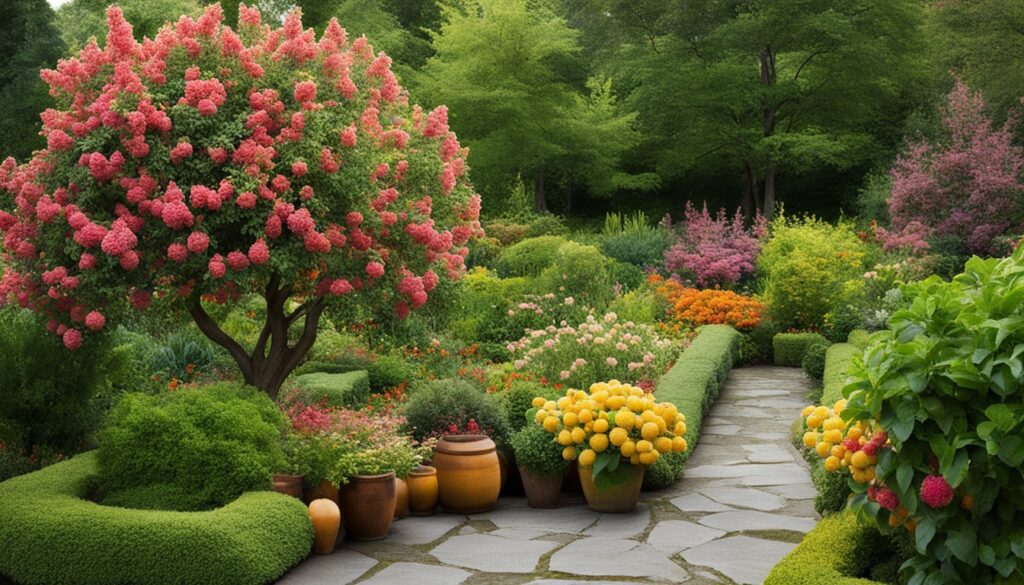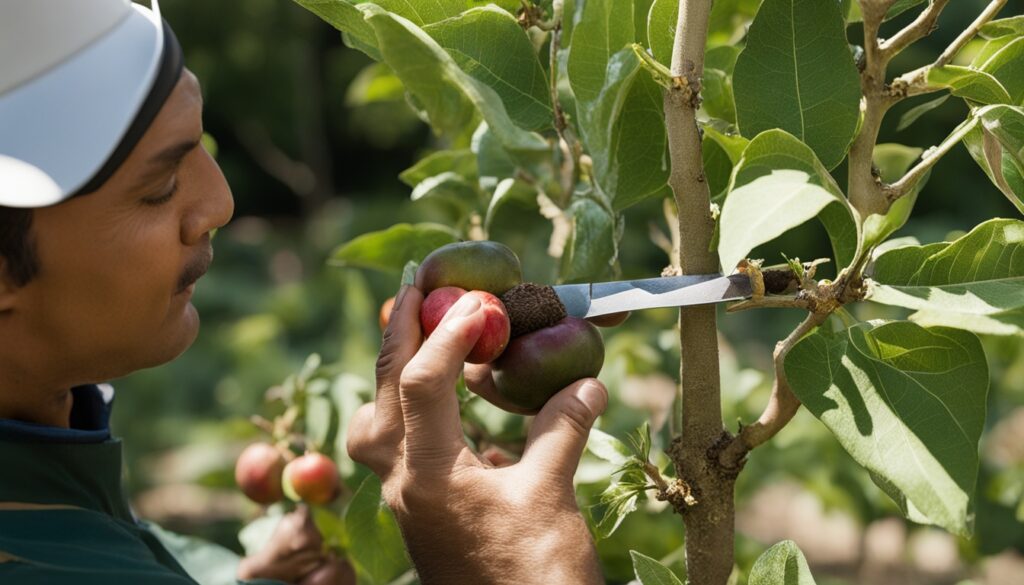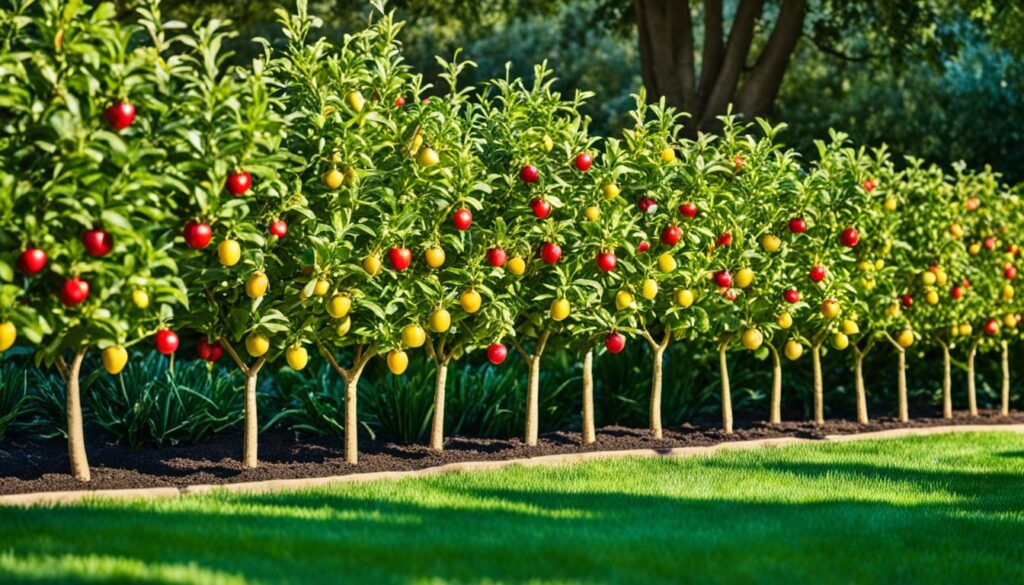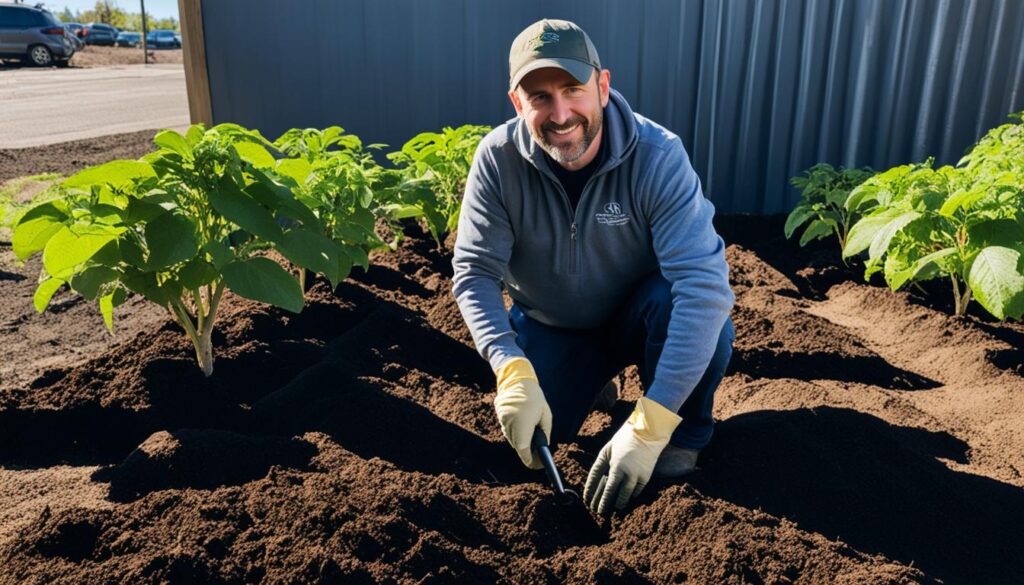
Do you want to taste fresh, homegrown fruit but have a small garden? Dwarf fruit trees are the answer. They let you grow a lot of fruit in a little space. Just imagine picking apples, pears, peaches, or citrus from your own small orchard.
Dwarf fruit trees change how we grow our own food. They are small, grow fast, and produce fruit quickly. This makes them perfect for city gardens. Start growing your own healthy fruits with these trees and enjoy tasty food from your small garden.
So, what makes these trees so special? Let’s learn about the science and art of growing dwarf fruit trees. We’ll show you how to pick the best trees for your garden. Join us to discover the joys of having a small, fruitful orchard in your backyard or on your patio.
Introduction to Dwarf Fruit Trees
Do you want to grow your own fruits but have little garden space? Dwarf fruit trees are a great choice! They are perfect for gardeners with small spaces. They give a big harvest without needing a lot of land.
What are Dwarf Fruit Trees?
Dwarf fruit trees are smaller and save space compared to regular trees. These small-sized fruit trees grow to be about 8 to 10 feet tall and wide. They produce lots of full-sized fruit without taking up much room.
Benefits of Growing Dwarf Fruit Trees
- Easier to care for, maintain, and harvest from the ground level
- Reach fruit-bearing maturity sooner than larger fruit trees
- Ideal for container fruit trees and space-saving fruit trees in small gardens
- Require less pruning due to their compact fruit trees nature
If you have a small backyard, a cozy patio, or even a balcony, manageable fruit trees can do well. They can give you a tasty, homegrown harvest. Check out dwarf fruit trees and enjoy growing your own fresh produce in small spaces.

The Science Behind Dwarfing Fruit Trees
Dwarf fruit trees are amazing thanks to grafting. A scion (a cutting or shoot) is joined to a rootstock of another plant. The rootstock’s choice is key. It affects the tree’s hardiness, how it handles drought, fights diseases, adapts to soil, and its size.
Rootstocks help control the tree’s growth. By pairing a scion with a rootstock, growers can set the tree’s size. This method has been around for thousands of years. It’s how we get the small, space-saving dwarf fruit trees for today’s gardens.
Understanding Rootstocks and Grafting
The secret to dwarfing fruit trees is picking hardy rootstocks that keep the tree small. These rootstocks come from smaller wild varieties or are bred for size control.
- Dwarf rootstocks, such as M27, can produce trees that only reach 4-6 feet tall.
- Semidwarf rootstocks, like M9 and M26, result in trees that grow 8-14 feet high.
- Larger, more vigorous rootstocks like MM111 can produce trees up to 20 feet tall.
By grafting a chosen scion (like an apple or pear) onto the right rootstock, growers can control the tree’s size. This grafting method is key to the dwarf fruit tree movement. It lets gardeners have a big harvest in small spaces.

Choosing the Right Dwarf Fruit Tree Varieties
Dwarf fruit trees are great for small spaces. They grow to be only 6-8 feet tall. This makes them perfect for gardens and patios. You can find everything from dwarf apple varieties to tasty dwarf pear varieties.
Apples
‘Honeycrisp’ and ‘Golden Delicious’ apples are popular choices. They grow well in USDA zones 3-7. They give you crisp, sweet, and juicy fruits.
‘Late Red Fuji’ apples are great for zones 5-8. They mix sweetness with spice. These trees fit well in containers or small gardens. They’re perfect for city and suburb living.
Pears
If you love pears, try ‘Bartlett’ and ‘Shinseiki’ trees. They grow in USDA zones 5-9. These trees give you medium-sized, juicy, and sweet pears.
Stone Fruits
Peach, nectarine, and plum fans will love the dwarf stone fruit trees. ‘Redhaven’ peaches grow in zones 5-8. They have firm, sweet, and juicy flesh.
‘Bing’ cherries are great for zones 5-8. They mix sweetness with a bit of tartness.
Citrus
If you live in a warm area, consider dwarf citrus trees. ‘Dwarf Meyer Lemon’ and ‘Dwarf Calamondin Orange’ are good choices. These trees grow well in containers or small gardens. They give you lots of fresh, fragrant citrus fruits.
Think about cold hardiness, heat tolerance, and pollination when picking a dwarf fruit tree. With the right tree and care, you’ll have a fruit tree that makes you happy for many years.

Planting and Growing Dwarf Fruit Trees
When planting dwarf fruit trees, picking the right spot is key. They love full sun, needing at least six hours of sunlight a day. Make sure they’re not near buildings or tall trees that could block the sun.
Site Selection and Sunlight Requirements
Make sure your dwarf fruit trees get enough sunlight. They need at least six hours of direct sun each day when they’re growing. This sunlight helps them bloom and give lots of fruit.
Soil Preparation and Drainage
Dwarf fruit trees like soil that drains well and is slightly acidic or neutral. If your soil is heavy clay, make a mound to help with drainage. This stops water from pooling around the tree. For sandy soil, add compost to keep the moisture in.
Put 2-4 inches of wood mulch around the tree. This keeps weeds away, saves water, and makes the soil better.
- Ideal soil conditions for planting dwarf fruit trees include loam or sandy loam with good drainage.
- Amend heavy clay soils by creating a raised planting bed to improve drainage.
- Enrich sandy soils with compost to enhance water-holding capacity and nutrient content.
- Apply 2-4 inches of wood mulch around the tree to suppress weeds and retain soil moisture.

Choosing the right spot and preparing the soil well will help yourdwarf fruit trees grow strong. They will give you lots of fruit.
Caring for Dwarf Fruit Trees
Looking after your dwarf fruit trees means taking good care of their watering, fertilizing, pruning, and training. By knowing what they need, you can get a lot of fruit every year.
Watering and Fertilizing
It’s key to water your dwarf fruit trees right. Don’t overwater them, especially if they’re in pots. Watch the soil and water only when it’s dry. When they’re bigger, they might need water every day in the growing season.
For fertilizing, use a fertilizer high in nitrogen once a year. Do this in the spring or early summer. Put the fertilizer a foot away from the trunk. Don’t give too much, as it can hurt the tree.
Pruning and Training
Pruning is vital for dwarf fruit trees. It keeps the tree looking good, helps it make more fruit, and gets rid of bad branches. Prune when the tree is asleep, usually in winter.
Training your trees makes them work better and stay small. You can use methods like espalier or hedgerow planting. These make your garden look nice and use space well.

By doing the right things with watering, fertilizing, pruning, and training, your dwarf fruit trees will do great. They’ll give you lots of fruit.
Dwarf Fruit Trees: Space-Saving Solutions
Space shouldn’t stop you from growing your own fruits. Dwarf fruit trees are great for small gardens. They let you have a big harvest without taking up much space.
Espalier Techniques
Espalier turns fruit trees into flat, wall-growing plants. By pruning and tying the branches, you get a beautiful, space-saving tree. Espalier fruit trees are perfect for small gardens and balconies, giving lots of tasty fruits in a little space.
Hedgerow Planting
Hedgerow fruit trees help you use space well. You plant dwarf trees close together, like a hedge. This way, you get a big harvest from a small area.
Container Gardening with Dwarf Fruit Trees
Container fruit trees are great for small spaces. They’re made for growing in pots and give you a full fruit garden in tight spots. Enjoy your compact fruit orchard on a balcony or patio.
These smart techniques let you grow a fruit garden in small spaces. With creativity and the right trees, you can have your own fruit harvest at home.
Pest and Disease Management
Dwarf fruit trees have many benefits but face challenges from pests and diseases. They can get pests like aphids and mites, and diseases like fungal infections and fire blight. But, you can keep these problems under control and enjoy lots of fruit from your trees.
Choosing disease-resistant fruit tree varieties is key to fighting pests and diseases. Many trees now resist common diseases, cutting down on the need for chemicals. For example, trees like CrimsonCrisp and Liberty fight apple scab disease well.
Using organic ways to control pests works great too. Ladybugs and lacewings can eat aphids and mites. Horticultural oils and insecticidal soaps are also good for fighting pests without harming the environment.
Good tree care helps keep pests away. Pruning trees and cleaning up leaves and fruit helps. This keeps trees healthy and means you use fewer chemicals. It makes taking care of pests organic and better for the planet.
| Pest or Disease | Affected Fruit Trees | Symptoms | Recommended Management |
|---|---|---|---|
| Apple Scab | Apples | Brown or olive green spots on leaves, black spots on fruit | Choose resistant varieties like CrimsonCrisp, Jonafree, Liberty, and Topaz |
| Flyspeck and Sooty Blotch | Apples | Blemishes on fruit surface | Improve air circulation through pruning, clean up fallen fruit and leaves |
| Cedar Apple Rust | Apples | Affects leaves and fruit, more prevalent near Eastern red cedar trees | Choose resistant varieties, remove nearby cedar trees |
| Black Knot | Plums, Cherries | Hard, black growths on twigs and branches | Prune and remove affected wood, choose resistant varieties like Shiro and Santa Rosa |
| Brown Rot | Stone Fruits (Cherries, Peaches, Apricots, Plums) | Fruit becomes soft and rotten during ripening | Improve air circulation, remove mummified fruit, choose resistant varieties |
Using disease-resistant fruit tree varieties, organic pest control, and good tree care helps fight pests and diseases. This keeps your trees healthy and reduces the need for harsh chemicals. It makes your garden better for the planet.
Harvesting and Enjoying Your Homegrown Fruits
Growing dwarf fruit trees lets you easily pick the tasty fruit they make. They’re small, so you don’t need ladders to get the fruit. This makes picking easy and fun. Eating your own fruit is a special treat that’s better for the planet and tastes amazing.
It’s important to know when different fruits are ready to pick. Some fruits, like persimmons and pears, should be picked early and then let ripen elsewhere. Others, like apples and plums, are best picked when they taste and feel just right. Keep an eye on your trees and pick at the right time to enjoy their best flavor and texture.
Not all fruits ripen at the same time, but you’ll have many harvests. Some trees might even have a biennial bearing pattern, meaning heavy or light crops every other year. Enjoy your fresh, chemical-free fruits right away, in recipes, or saved for later.
Having dwarf fruit trees in your garden or pots means lots of fresh, tasty fruit for you. With the right care, you’ll have a steady supply of delicious fruits. They’ll make your meals better and keep you healthy.
Dwarf Fruit Trees for Small Spaces
If you have little space, dwarf fruit trees are great for growing your own tasty fruits. They fit well in small backyards, cozy patios, or even sunny spots on your balcony. These trees are perfect for container growing or tight planting. They let you enjoy fresh produce in urban or small-scale settings.
Dwarf fruit trees offer many flavors and types, like apples, peaches, citrus, and berries. Self-pollinating trees are great for small yards because they pollinate themselves. Some popular dwarf fruit trees include:
- Dwarf Apple Trees: Gala, Granny Smith, Red Jonathan
- Dwarf Berry Trees: Dwarf Everbearing Mulberry, Prime Ark Freedom Blackberry, Tifblue Blueberry
- Dwarf Peach Trees: Bonfire Patio Peach, Semi Dwarf Snowbrite White Peach, FlordaCrest Peach
- Dwarf Persimmon Trees: Ichi Ki Kei Jiro Persimmon, Fuyu Jiro Persimmon
Dwarf fruit trees grow to be 8-10 feet tall. They’re ideal for small yards, patios, and container gardening. Smaller trees like the 3-foot Meyer Lemon Bonsai and the 7-15 foot Dwarf Orange Tree also do well in small spaces. With proper care, you can have your own backyard orchard in the city.
Tips for Successful Dwarf Fruit Tree Cultivation
Maintaining dwarf fruit trees needs some key tips for them to do well. You might need to stake or anchor them to stop them from falling over. This is especially true for trees on highly dwarfing rootstocks.
It’s important to water them regularly but not too much. Also, prune them every year to get rid of suckers, water sprouts, and some new growth. Using espalier training can help keep them small and productive.
Knowing what dwarf fruit trees need helps you grow them well. Susan Poizner, from «Grow Fruit Trees Fast: A Beginner’s Guide to a Healthy Harvest in Record Time,» says picking the right tree and knowing its type is key. This helps you avoid mistakes in growing fruit trees.
Whether you’re growing apples, pears, or stone fruits, pay attention to what dwarf varieties need. With the right care, your small fruit trees will do great. They’ll give you a tasty harvest every year.



